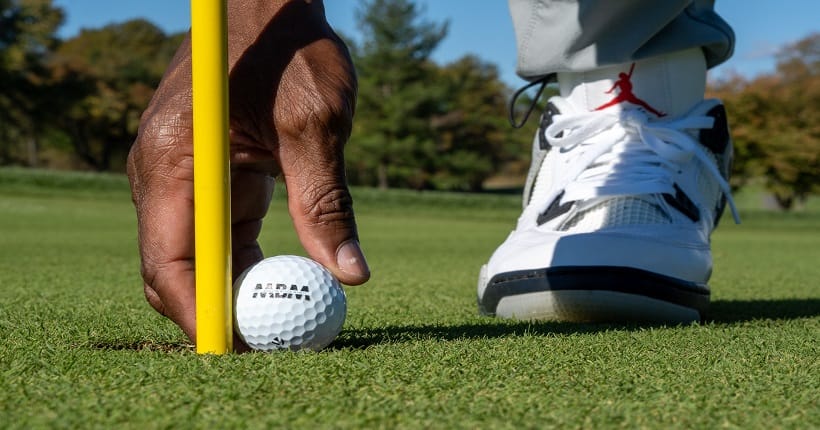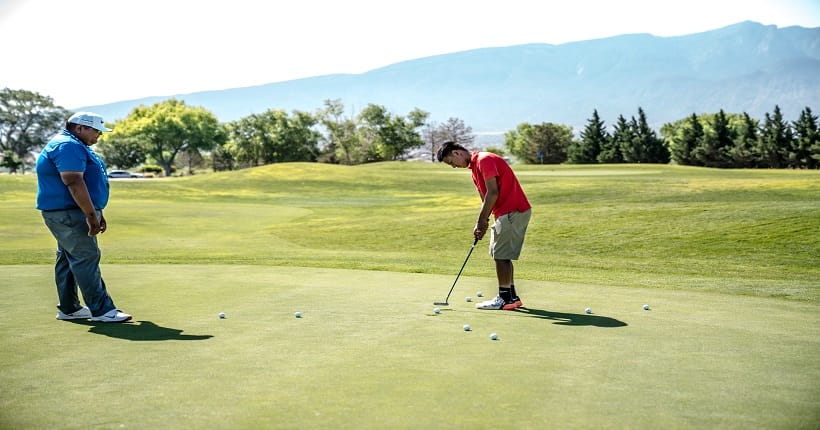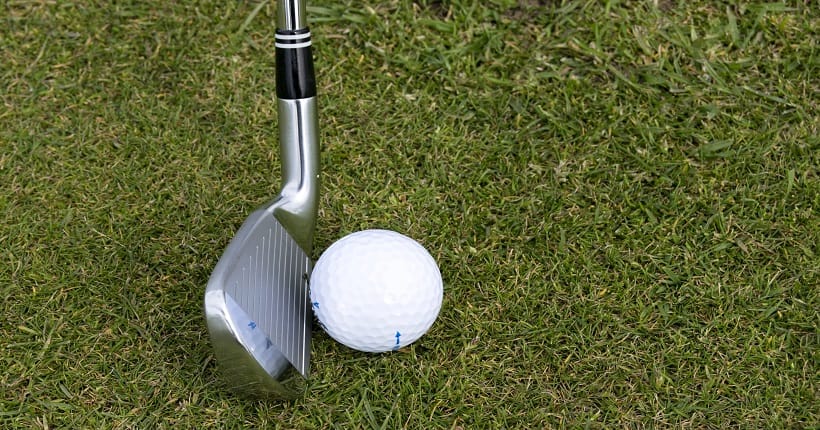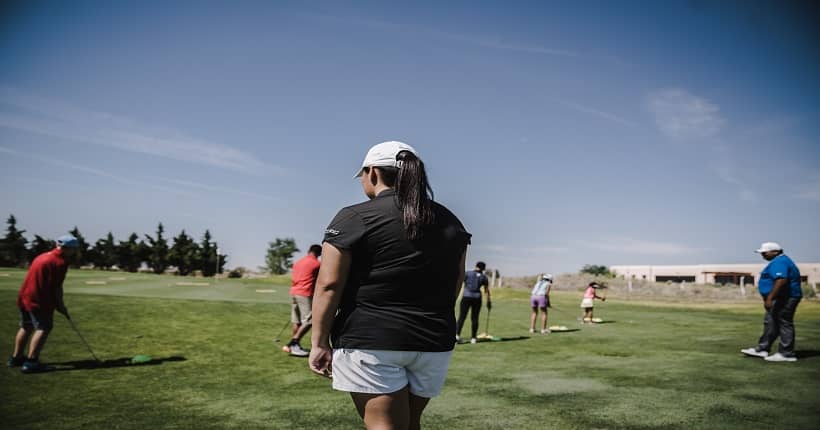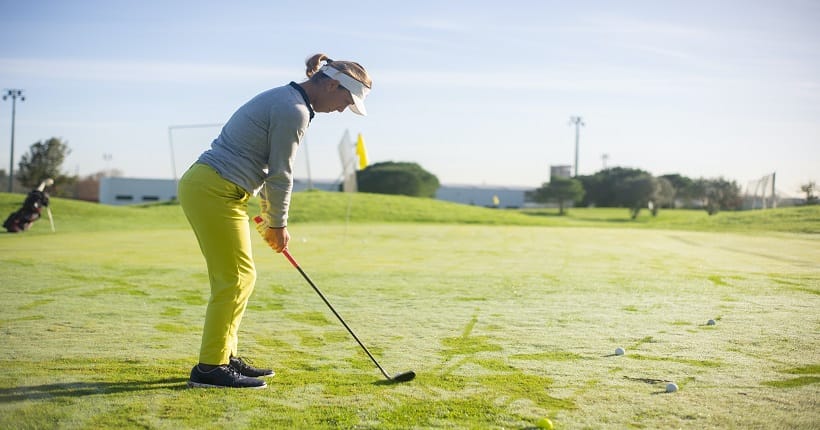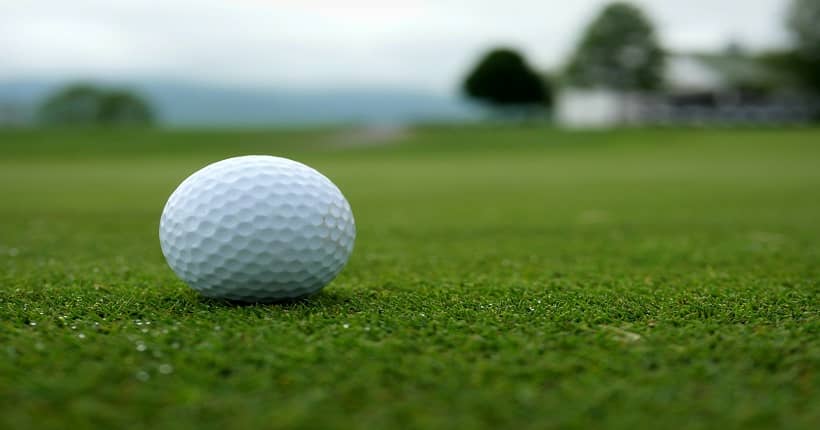How To Put Backspin On A Golf Ball?
To put backspin on a golf ball, you need to focus on striking the ball cleanly and imparting a downward force with a steep swing path and an open clubface at impact. Golfers who are looking to add finesse and control to their game often aim to put backspin on the golf ball.
Backspin, also known as topspin, refers to the spin applied to the ball that causes it to stop or even spin backward upon landing. This technique can be particularly useful for approaches to the green or shots that require precision and stopping power.
To achieve backspin, you must strike the ball cleanly, ensuring a solid connection with the clubface. Additionally, maintaining a steep swing path and an open clubface at impact will help create the desired spin. Remember to follow through your swing, staying committed to the shot and maximizing your chances of achieving backspin. With practice and proper technique, you can add this valuable skill to your golfing repertoire.
The Science Of Backspin
When it comes to mastering the art of golf, understanding the science behind backspin can make all the difference. Backspin is the phenomenon that occurs when the golf ball rotates backward as it flies through the air. This rotation creates lift, allowing the ball to stay in the air longer and increase its stability upon landing. To achieve backspin, golfers need to focus on various factors that affect its creation. Let’s take a closer look at these factors and explore the importance of spin control in the game of golf.
Factors Affecting Backspin
Creating effective backspin involves more than just a standard swing. It requires an understanding of the key factors that influence the spin of the golf ball. Here are some important elements to consider:
- Clubhead speed: The faster the clubhead travels at impact, the more spin potential it generates on the ball.
- Angle of attack: The angle at which the club strikes the ball plays a crucial role in determining the amount of backspin. A steeper angle of attack produces more backspin.
- Quality of strike: Hitting the ball with the club’s sweet spot leads to cleaner contact, resulting in better spin control.
- Groove design: The design and condition of the club’s grooves can significantly impact how much spin is imparted on the ball.
Importance of Spin Control in Golf
In golf, mastering spin control is vital for players of all skill levels. Why? Let’s explore its significance:
- Shot shaping: Controlling backspin allows golfers to shape their shots, enabling them to maneuver the ball around obstacles or position it strategically on the green.
- Greenside control: Proper spin control gives golfers the ability to stop the ball quickly on the green, reducing the risk of overshooting the hole.
- Distance control: Backspin helps golfers achieve consistent distance control by allowing them to regulate how far the ball carries before it lands, enhancing shot accuracy.
- Course conditions: Different playing surfaces and weather conditions demand varying amounts of spin. Developing spin control skills provides an advantage in adapting to these conditions.
By understanding the factors that affect backspin and recognizing the importance of spin control in golf, you can take your game to a whole new level. Incorporating these insights into your practice sessions will help you achieve the desired backspin on your shots, allowing you to navigate the course with confidence and precision.
Developing The Perfect Setup
When it comes to putting backspin on a golf ball, the setup is crucial. Developing the perfect setup involves optimizing your ball positioning, selecting the correct club, and using the right grip techniques for spin control. In this article, we will explore each of these aspects in detail to help you master the art of putting backspin on your golf shots.
Optimal ball positioning
One of the key factors in creating backspin on a golf ball is achieving the optimal ball positioning. Proper ball placement in your stance can greatly impact the amount of spin you can generate. To achieve maximum backspin, follow these guidelines:
| Iron shots: | Position the ball slightly back of center in your stance, towards your trailing foot. This promotes a steeper angle of attack, allowing the clubface to make solid contact with the ball and generate spin. |
| Wedge shots: | For wedge shots, place the ball even further back in your stance, towards the center or closer to your leading foot. This allows for an even steeper angle of attack, ensuring more backspin. |
Correct club selection
Choosing the right club for generating backspin is essential. Wedges, particularly sand wedges and lob wedges, are known for their ability to impart significant spin on the golf ball. These clubs have higher lofts and sharper grooves, which enhance spin generation. When attempting to put backspin on your shots, consider using a higher lofted wedge to increase your chances of success.
Grip techniques for spin control
The grip you use on your golf club can also influence the amount of backspin you can produce. Here are a few grip techniques to help you improve spin control:
- The Vardon Grip: Also known as the overlapping grip, this grip style is a popular choice among golfers. It provides stability and control, allowing you to better manipulate the clubface and create more backspin.
- The Interlocking Grip: In this grip style, the pinky finger of the trailing hand interlocks with the index finger of the leading hand. This grip can enhance your ability to maintain a firm hold on the club, enabling better control over the clubface and increased spin.
- The Baseball Grip: While not as common as the other two grips, the baseball grip can offer a unique feel and control. This grip involves placing all ten fingers directly on the club, providing a more secure grip and potential for greater spin.
Experiment with these grip techniques to find the one that suits you best and allows for optimal spin control on the golf ball.
In conclusion, achieving the perfect setup is crucial for putting backspin on a golf ball. By positioning the ball correctly, choosing the right club, and using appropriate grip techniques, you can enhance your ability to generate backspin and take your golf game to the next level. Practice these techniques and watch as your shots start to stop on a dime with impressive backspin!
Mastering The Swing Technique
When it comes to putting backspin on a golf ball, mastering the correct swing technique is crucial. Generating clubhead speed, incorporating proper body rotation, and achieving a shallow angle of attack are three key factors that can help you achieve the desired backspin on your shots. In this article, we will delve into each of these aspects and provide you with practical tips to improve your golf swing and add that spin to your shots.
Generating clubhead speed
To create the necessary backspin on the golf ball, you need to generate sufficient clubhead speed. This allows for a clean and crisp contact between the clubface and the ball. One effective way to generate clubhead speed is by ensuring a smooth and fluid swing. Keep these points in mind:
- Maintain a relaxed grip on the club throughout your swing.
- Start your swing with a gradual backswing, allowing your body to build up momentum.
- As you transition into the downswing, focus on a quick acceleration of the clubhead towards the ball.
By following these guidelines, you will enhance your chances of generating sufficient clubhead speed and increasing your chances of putting backspin on the ball.
Incorporating proper body rotation
The next important aspect to master is incorporating proper body rotation into your swing. This helps create a more powerful and controlled swing, which in turn contributes to the desired backspin on the ball. Here’s how you can improve your body rotation:
- Ensure a stable base by positioning your feet shoulder-width apart.
- During the backswing, rotate your shoulders and hips in sync, creating torque.
- As you transition into the downswing, focus on proper weight transfer from your back foot to your front foot.
- Allow your hips to rotate towards the target, ensuring efficient energy transfer through the swing.
By incorporating these steps into your swing, you will improve your body rotation and increase your chances of achieving that desired backspin on the golf ball.
Achieving a shallow angle of attack
Lastly, achieving a shallow angle of attack is crucial to creating backspin on the golf ball. A steep angle of attack often results in a low trajectory shot without much spin. To achieve a shallow angle of attack, consider the following:
- Position the ball slightly forward in your stance, towards your front foot.
- Focus on sweeping the ball off the ground, rather than hitting down on it.
- Maintain a smooth and shallow descent with your clubhead as it approaches the ball.
By focusing on these techniques, you will be able to achieve a shallower angle of attack, allowing for better contact with the ball and increasing your chances of putting backspin on your shots.
By mastering these essential swing techniques – generating clubhead speed, incorporating proper body rotation, and achieving a shallow angle of attack – you will significantly improve your ability to put backspin on a golf ball. Practice these techniques consistently, and soon you’ll be impressing your playing partners with your ability to control the spin of your shots.
Using The Right Equipment
The key to putting backspin on a golf ball lies in using the right equipment. By choosing the right golf ball and selecting a wedge with optimal characteristics, you can enhance your chances of generating the desired backspin. Let’s take a closer look at these crucial factors.
Choosing the right golf ball for spin
When it comes to generating backspin, not all golf balls are created equal. To achieve maximum spin, it’s essential to select a ball specifically designed for this purpose. Look for golf balls with a soft cover, as they are more responsive and provide greater control.
| Golf Ball Features for Spin | Explanation |
|---|---|
| Urethane Cover | Golf balls with a urethane cover offer excellent spin control due to their soft and responsive nature. |
| High Spin Rate | Choosing a ball with a high spin rate enables better grip on the clubface, resulting in more backspin on your shots. |
| Low Compression | Opt for golf balls with low compression, as they allow for greater deformation, promoting increased spin upon contact. |
Selecting wedge with optimal characteristics
Aside from the golf ball, the wedge you use plays a vital role in producing backspin. Consider the following factors when selecting a wedge:
- Loft: Choose a wedge with a higher loft angle, typically in the range of 54 to 60 degrees. Higher loft angles create more spin and trajectory.
- Grooves: Look for wedges with deep and sharp grooves. These help create friction between the ball and the clubface, resulting in greater backspin.
- Bounce: Opt for wedges with moderate bounce to prevent excessive digging or bouncing off the turf, leading to more accuracy and better spin.
- Face Texture: A wedge with a milled or rougher face texture can increase friction and generate additional spin on the ball.
By paying attention to these wedge characteristics, you can maximize your chances of generating backspin on the golf ball.
Remember, using the appropriate golf ball and selecting the right wedge go hand in hand when it comes to achieving backspin. Take advantage of the tips mentioned here, and you’ll soon be executing impressive shots with remarkable control and spin.
Perfecting The Impact
When it comes to putting backspin on a golf ball, one of the most critical aspects is perfecting the impact. This is the point of contact between the clubface and the ball, and it can make all the difference in generating that desired backspin. In this section, we will delve into two key factors that contribute to a perfect impact: hitting down on the ball and creating a clean ball strike.
Hitting down on the ball
In order to create backspin on a golf ball, it’s essential to hit down on the ball rather than scooping it. By striking down on the ball, you compress it against the clubface and generate the necessary friction that leads to backspin. To achieve this, there are a few key pointers to keep in mind:
- Position the ball slightly back in your stance, closer to your trailing foot. This helps promote a more downward strike.
- Focus on maintaining a descending angle of attack. This means that the clubhead should be descending into the ball at impact.
- Maintain a firm wrist throughout the swing. This prevents any unwanted flipping or scooping motion that can reduce the ability to strike down on the ball.
Creating a clean ball strike
In addition to hitting down on the ball, creating a clean ball strike is essential for maximizing spin. A clean strike minimizes any unwanted side spin or vibrations that can hinder the backspin effect. Here are some tips to ensure a clean strike:
- Focus on hitting the ball with the center of the clubface. This provides the most solid and consistent contact.
- Keep your eyes on the ball throughout the swing. This helps maintain focus and ensures a centered strike.
- Practice your swing tempo and timing to develop a consistent ball strike. This includes maintaining a smooth and fluid motion without any jerky movements.
By hitting down on the ball and creating a clean strike, you’ll greatly improve your chances of putting backspin on a golf ball. Remember, mastering these aspects takes practice and repetition. Incorporate these techniques into your training sessions, and soon enough, you’ll be able to impress your fellow golfers with those impressive backspins!

Credit: theleftrough.com
Practice Drills For Backspin
Learning to put backspin on a golf ball can take your game to the next level. While it may seem like an advanced technique, with practice and the right drills, anyone can master it. In this section, we will discuss some effective practice drills that can help you achieve that coveted backspin on your shots. By focusing on contact and control and implementing progressive difficulty levels, you will be well on your way to adding an impressive backspin to your golf game.
Focusing on contact and control
When it comes to putting backspin on a golf ball, one of the essential elements is achieving solid contact and control. These drills will help you improve your ability to strike the ball cleanly and generate effective backspin:
- The Towel Drill: Lay a towel on the ground and practice hitting shots off it. The goal is to take divots that start after the towel, indicating a downward strike on the ball. Focus on maintaining a steep angle of attack and hitting the ball first before the ground.
- The Coin Drill: Place a coin around three inches in front of the ball. Concentrate on hitting the coin after making contact with the ball. This drill will train you to strike the ball first and encourage a downward angle of attack.
- The Impact Bag Drill: Use an impact bag or a heavy pillow and swing down into it, focusing on achieving a downward strike. The resistance provided by the bag will improve your control and help you maintain a clean strike.
Implementing progressive difficulty levels
To further enhance your ability to put backspin on a golf ball, it is essential to challenge yourself with drills of increasing difficulty. Gradually progressing through different levels will allow you to build upon your skills and develop consistency. Here are some progressive practice drills:
- Short Iron Drill: Start with a wedge or a short iron and focus on creating backspin on your shots. Once you master this, move on to longer irons and eventually incorporate backspin into your drives.
- Uneven Lie Drill: Practice hitting shots on uneven lies, such as uphill or downhill slopes. This drill will challenge your ability to control the clubface and generate backspin under different conditions.
- Bunker Drill: Head to the practice bunker and practice hitting shots that create backspin. The sandy surface will make it easier to generate backspin, and this drill will improve your ability to control the ball’s trajectory and spin.
By incorporating these practice drills into your training routine, you will gradually improve your ability to generate backspin on a golf ball. Remember, practice makes perfect, so stay dedicated and persistent. With time and effort, you will be able to execute impressive shots with that satisfying backspin effect.
Advanced Techniques For Enhanced Spin
If you’re an avid golfer looking to take your game to the next level, mastering the art of putting backspin on a golf ball can be a game-changer. Backspin not only adds a touch of finesse to your shots but also allows you to control the trajectory and roll of the ball. In this section, we’ll explore advanced techniques that can help you enhance your spin game.
Manipulating loft and clubface angles
One of the key factors in achieving enhanced spin is manipulating the loft and clubface angles. By adjusting these elements, you can maximize the backspin and achieve the desired control over your shots.
Here are a few tips to cosider:
- Varying the loft angle: The loft angle of your golf club plays a crucial role in generating backspin. To increase spin, try using clubs with higher loft angles, such as wedges or sand wedges. These clubs create a steeper angle of attack and allow for more spin-inducing contact with the ball.
- Opening the clubface: Another way to enhance spin is by opening the clubface slightly at address. By doing so, you increase the effective loft of the club, which can create more backspin on the ball. Experiment with different degrees of opening the clubface to find what works best for you.
Utilizing the bounce of the club
The bounce of the club refers to the curved underside of the clubhead. While it primarily assists in preventing the club from digging too deeply into the turf, it can also be utilized to generate more backspin.
Here’s how you can make the most of the club’s bounce:
- Using the club’s sole: Place the club’s sole in contact with the ground ahead of the ball during your address. This positions the clubhead slightly behind the ball and allows the bounce to interact with the turf, effectively adding more loft and spin to your shots.
- Attacking the ball at a descending angle: When executing the shot, focus on maintaining a shallow angle of approach to the ball. This means striking down on the ball slightly, rather than scooping it. By doing so, you maximize the interaction between the club’s bounce and the ball, resulting in increased backspin.
Remember, mastering advanced techniques for enhanced spin takes practice, patience, and experimentation. Incorporate these methods into your training regimen, and with consistency, you’ll soon notice a significant improvement in your ability to put backspin on a golf ball.
Course Management Strategies
When it comes to improving your golf game, course management strategies play a crucial role. One often overlooked aspect of course management is the ability to put backspin on a golf ball. This skill not only adds a touch of finesse to your shots but also allows you to control the ball’s landing and roll on the green. In this section, we will explore two key strategies for putting backspin on a golf ball – analyzing green slopes and pin positions, and adjusting shot strategy for maximum spin.
Analyzing green slopes and pin positions
Before executing any shot, it is essential to gather information about the green slopes and pin positions. Analyzing the slopes will help you determine the direction and intensity of the backspin you need to apply. Look for subtle breaks and undulations that can significantly affect the ball’s behavior after it lands on the green.
Furthermore, pay close attention to the pin positions. If the pin is tucked away near the edge of the green or behind a bunker, you may want to prioritize accuracy over spin. Conversely, if the pin is accessible and there is ample green to work with, focusing on generating backspin can be advantageous.
Adjusting shot strategy for maximum spin
Once you have assessed the green slopes and pin positions, it’s time to adjust your shot strategy to maximize backspin. Here are a few tips to help you achieve this:
- Selecting the right club: Choosing the appropriate club is crucial for generating backspin. Generally, the closer you are to the green, the fewer clubs you need to consider. Wedges, such as sand wedges or lob wedges, are known for their ability to create substantial backspin.
- Steeper angle of attack: To generate more backspin, you want to create a steeper angle of attack when striking the ball. This means striking down on the ball rather than sweeping it. A steeper angle of attack promotes cleaner contact between the clubface and the ball, allowing for more grip and spin.
- Ball position and weight transfer: Placing the ball slightly back in your stance and transferring your weight onto your front foot during the downswing can help create a steeper angle of attack. This technique enables you to make solid contact with the ball and impart more spin.
- Accelerate through impact: Keeping a smooth and controlled swing is crucial, but you need to accelerate through impact to maximize backspin. Focus on a crisp, clean strike with plenty of power to create the necessary spin on the ball.
- Utilize the grooves on your clubface: The grooves on your clubface are specifically designed to enhance spin. Before each shot, ensure that your clubface is clean and dry to optimize the friction between the ball and the clubface.
By implementing these adjustments to your shot strategy and considering the green slopes and pin positions, you can increase your chances of putting backspin on a golf ball successfully. Remember, practice is key, so head to the driving range or practice green to refine your technique and improve your overall golf game.
Common Mistakes To Avoid
Common errors in setup and swing
Correct setup and swing are crucial for generating backspin on a golf ball. However, many golfers make common errors that hinder their ability to achieve the desired results. By avoiding these mistakes, you can significantly improve your chances of getting that coveted backspin on your shots.
- Improper grip: One of the most common mistakes is an improper grip. If you hold the club too tight or too loose, it can affect your ability to generate sufficient backspin. Ensure that your grip is firm but not too tight, allowing for proper control and leverage during your swing.
- Incorrect ball position: Another common error is placing the ball too far forward or too far back in your stance. This can lead to inconsistent strikes and a lack of backspin. Find the ideal ball position, typically just ahead of center, to maximize your chances of achieving the desired spin.
- Poor body alignment: Misalignment of your body can greatly impact your ability to generate backspin. Make sure your shoulders, hips, and feet are properly aligned with the target. This alignment will help you make solid contact with the ball and create the necessary spin.
Troubleshooting lack of backspin
If you’re finding it difficult to put backspin on your golf ball, don’t worry. There are a few troubleshooting techniques you can try to enhance your spin rate:
- Check your clubface angle: Ensure that your clubface is in the correct position at impact. A closed or open face can lead to reduced spin. Practice maintaining a square clubface to maximize your backspin potential.
- Focus on a downward strike: To generate backspin, you need to make contact with the ball on a downward trajectory. A shallow angle of attack can result in less spin. Strive to strike the ball with a slightly descending blow to optimize backspin.
- Use the right ball: The type of ball you use can also impact your ability to achieve backspin. Look for golf balls that are designed to promote spin, such as those with urethane covers. These balls offer better control and increased spin potential.
By avoiding common mistakes in setup and swing and employing troubleshooting techniques, you can put backspin on your golf ball like a pro. Practice these tips consistently to improve your spin rate and elevate your game to new levels.
Enhancing Spin With Ball Markings And Maintenance
In the world of golf, mastering spin control is a skill that can greatly improve your game. The ability to put backspin on a golf ball allows you to create shots that stop quickly on the green, giving you more control over your approach and chip shots.
Benefits of ball markings for spin control
Did you know that ball markings can actually help you enhance spin on a golf ball? It may seem like a small detail, but the markings on a golf ball can make a big difference in the amount of spin you are able to generate.
Here are a few benefits of ball markings for spin control:
- Improved Alignment: The alignment aid on a golf ball can help you line up your shots more accurately, allowing you to make cleaner contact with the ball, which in turn can lead to enhanced spin.
- Consistency: Using a golf ball with consistent markings can help you develop a consistent swing path and strike pattern, which can result in greater spin control.
- Better Trackability: Ball markings can make it easier to track the flight path of your shots, helping you analyze and adjust your technique to achieve optimal spin.
By taking advantage of the benefits of ball markings, you can optimize your spin control and take your golf game to the next level.
Proper ball maintenance for optimal performance
While ball markings play a role in enhancing spin, proper ball maintenance is equally important for optimal performance on the course. Taking care of your golf balls can help prolong their lifespan and ensure they maintain their desired characteristics.
Here are a few tips for proper ball maintenance:
- Cleaning: Regularly clean your golf balls with warm water and mild soap to remove any dirt or debris that can affect spin performance. Avoid using harsh chemicals or abrasive materials that can damage the surface of the ball.
- Storage: Store your golf balls in a cool, dry place to prevent them from getting overly exposed to heat or moisture, which can alter their performance.
- Inspection: Before each round, carefully inspect your golf balls for any signs of damage or wear. Replace any balls that have noticeable cuts, scuffs, or deformations.
By following these simple maintenance tips, you can ensure that your golf balls are in top condition, allowing you to maximize spin control and improve your overall performance on the course.
Frequently Asked Questions On How To Put Backspin On A Golf Ball?
How Do You Put Backspin On A Golf Ball With A Wedge?
To put backspin on a golf ball with a wedge, strike the ball with a descending, open-faced clubface.
How Do I Get More Backspin On My Irons?
To get more backspin on your irons, try these tips: 1. Use clean, high-quality golf balls with a soft cover for better grip on the clubface. 2. Strike the ball with a slightly descending angle of attack to create more friction between the clubface and the ball.
3. Focus on generating more clubhead speed through proper swing mechanics and a smooth tempo. 4. Position the ball slightly further back in your stance and make crisp contact to maximize spin.
How Do You Put Backspin On Chip Shots?
To put backspin on chip shots, strike the ball with a descending blow and open the clubface slightly at impact.
How Do You Throw A Ball With Backspin?
To throw a ball with backspin, rotate your wrist downwards and flick your fingers to create a spin.
How Do You Put Backspin On A Golf Ball?
To put backspin on a golf ball, ensure you make clean contact with the ball using a slightly open clubface and downward strike.
Conclusion
Putting backspin on a golf ball can elevate your game to a whole new level. By following the techniques outlined in this blog post, you can learn how to master this skill with ease. First, focus on striking the ball with a slightly open clubface, which will create the necessary loft for backspin.
Secondly, hone your technique by making clean contact with the ball, ensuring that you strike it with a descending blow. Lastly, experiment with different types of shots and practice until you find the right amount of spin for each situation.
Remember, patience and persistence are key in mastering this skill. So don’t get discouraged if it takes some time to achieve the desired results. With practice and dedication, you’ll soon become proficient at putting backspin on a golf ball, impressing your fellow players and taking your game to new heights.

